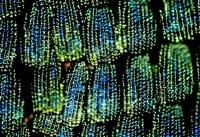Jun 5 2010
A University of Cambridge research team has combined the knowledge of vivid colours of butterfly wings with nanofabrication technology to mimic the nature’s optical structures. Researcher Mathias Kolle, who works with professors Ullrich Steiner and Jeremy Baumberg of the University of Cambridge, studied the Swallowtail butterfly, also called the Indonesian Peacock (Papilio blumei). The results of the research have been published in Nature Nanotechnology.
 Green Wings of P. blumei Butterfly
Green Wings of P. blumei Butterfly
Kolle said that the butterfly appears to its mates in one colour and to its predators in a different colour, as wing scales are made up of intricate, optical structures. If the green patches on the butterfly’s wings are viewed with optical equipment, the patches appear bright blue. However, the patches appear green if viewed with naked eye.
Employing nanofabrication procedures, including atomic layer deposition and self-assembly, Kolle and his team created structurally identical replicas of butterfly scales. Kolle said that with the help of such artificial optical structures, information could be encrypted in security printing applications. Bank notes, passports and credit cards can be created with optical structures to make them forgery-proof.